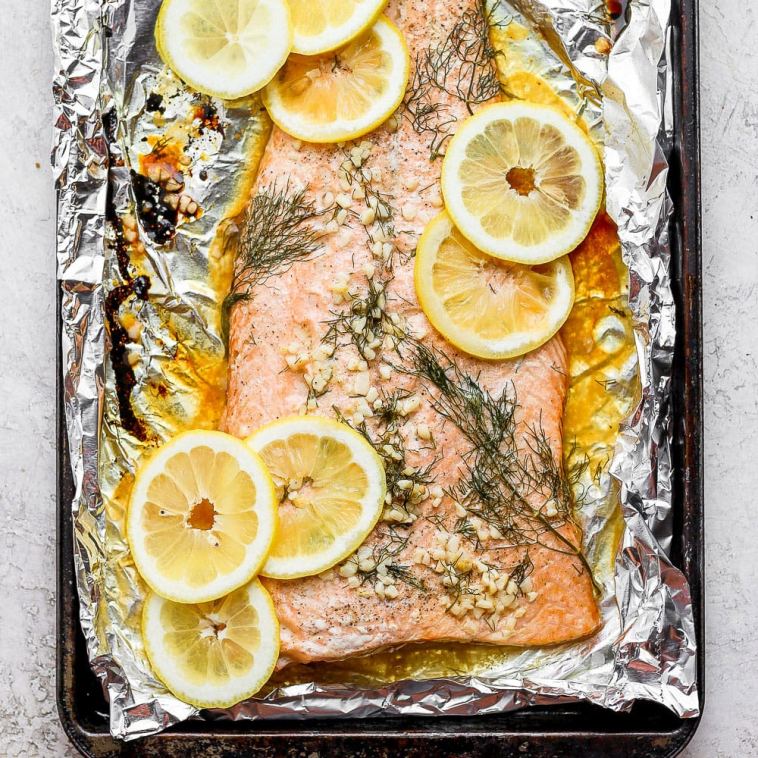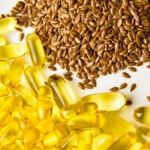- Like
- SHARE
- Digg
- Del
- Tumblr
- VKontakte
- Flattr
- Buffer
- Love This
- Save
- Odnoklassniki
- Meneame
- Blogger
- Amazon
- Yahoo Mail
- Gmail
- AOL
- Newsvine
- HackerNews
- Evernote
- MySpace
- Mail.ru
- Viadeo
- Line
- Comments
- Yummly
- SMS
- Viber
- Telegram
- JOIN
- Skype
- Facebook Messenger
- Kakao
- LiveJournal
- Yammer
- Edgar
- Fintel
- Mix
- Instapaper
- Copy Link
This perfectly cooked oven baked salmon in foil will give your family a delicious, healthy meal! It’s naturally gluten-free and high-protein.
This baked salmon recipe is first marinated in a delicious lemon garlic sauce, then wrapped in tin foil and baked to a flakey perfection!
This oven baked salmon with lemon, garlic, and dill really hits it home! It’s flavorful, tender, juicy, and so simple to make! It is by far one of my favorite recipes for salmon and I can’t wait for you to try it!
What is Baked Salmon in Foil?
Baked salmon in foil simply refers to a salmon fillet (or fillets) being wrapped in tin foil and then baked in the oven. The tinfoil boat creates a steam trap for the salmon, which helps it cook evenly throughout and infuses the salmon with whatever ingredients you flavor it with.
Why Baked Salmon?
There are so many different ways to cook salmon –> on the stove, grill, Instant Pot, slow cooker, smoked, and more! Baked Salmon in foil is by far my favorite because it’s 100% foolproof. Baked Salmon in foil…
- Comes out perfect every time
- Serves a crowd
- Is flakey and moist
- Is done is less than an hour
I especially love the method of wrapping your salmon in foil because you can use a large salmon filet that serves 4-6 people.
We’ve tested this recipe with salmon filets ranging in size (2 lbs. to 4 lbs.) and it really does come out perfect every time.
What kind of salmon should you use?
Salmon is one of those foods where quality MATTERS. We recommend using wild-caught vs. farmed salmon where no pesticides or antibiotics are used of any kind. We especially love the brand Surrender Salmon, which sells wild-caught sockeye salmon from Bristol Bay, Alaska.
This particular recipe calls for a 2.5 – 3 lb. uncooked salmon fillet. You can use a salmon fillet that has either the skin on or off, but we prefer skin-on because it adds a really nice layer of fat (yes I said it!) and flavor.
How big is a serving of salmon? A single serving of salmon is anywhere from 3 – 4 oz.
Can’t find a 2.5 lb. fillet? Here’s what to do.
Salmon fillets come in all shapes in sizes. A fillet refers to half a salmon and can range from 1.5 – 5 lbs.
If you can’t find a large salmon fillet, you can always use “salmon portions,” which just refers to cut-up pieces of a large salmon fillet. I suggest placing them right next to each other to mimic a larger salmon filet so that you can use the same bake time we recommend.
If you can only find a salmon fillet that’s less than 2.5 lbs., simply decrease the bake-time. Start with 20 minutes and go from there.
How to Bake Salmon – in 3 Steps
Marinate in Garlic + Lemon + Dill
Every baked salmon fillet should start with a delicious salmon marinade that infuses flavor into the entire part of the fish. That’s why the first step in how to bake salmon is marinading your salmon filet for at least 2 hours (or longer).
We kept the salmon marinade very basic, but flavorful at the same time. We want to make sure that the natural salmon flavors aren’t overpowered, rather enhanced. Insert >> garlic, lemon, and dill ?
Here’s what you need:
- olive oil – really any oil will work for this!
- lemon juice – use fresh lemon juice…ALWAYS.
- dijon mustard – a little bit of dijon is absolutely delicious in this marinade.
- honey – honey helps brighten things up and balance the citrus.
- fresh chopped dill – fresh dill is extremely aromatic and makes this recipe oh-so-delicious. Use fresh, if possible!
- salt and pepper – s&p…always!
- garlic – garlic is the base flavor of this recipe. Feel free to add even more if you’re a garlic fanatic like us!
Once you mix up your easy salmon marinade, transfer it to the bottom of a tin-foil lined baking sheet. Then, flip the salmon over and let it marinade skin-side down for 20 minutes to 2 hours.
here’s a tip
Make sure not to marinade things for too long or the acid from the lemons can actually start to cook the fish.
Other Marinade Ideas
Want to get sassy with your salmon marinade? Be my guest! You can use so many different things for marinades such as sauces and salad dressings. Here are a few more flavor combos for you to test out:
- Teriyaki – use our teriyaki chicken marinade, I promise it’s DELISH.
- BBQ – Mix some bbq sauce with a little water or oil and slather it on your salmon!
- Balsamic – feel free to use a balsamic dressing for this. You can do a storebought variation or make your own.
How much marinade for a 2 lb. salmon filet should you use? Plan on using anywhere from 1/2 cup to 3/4 of a cup of marinade to fully coat your salmon.
Tin Foil
Once your delicious salmon has marinaded for a substantial amount of time, it’s time to create tin foil boat. This is, after all, baked salmon in foil!
There are a few different ways to create a tin foil boat, but the main purpose is to prevent the salmon from touching outside air and to create a steam trap so that the salmon can cook evenly and faster.
Your salmon should already be marinading on a baking sheet that’s on a piece of tin foil. You can simply place a piece of tin foil on top of the cookie sheet and seal it off that way or, you can connect the bottom piece of tin foil with a second piece to create a true “boat.”
Bake
Wondering what the best baked salmon temp is? Preheat your oven to 375ºF. We’ve found that this is the perfect temperature for baked salmon in foil.
How long to bake salmon at 375ºF?
Bake your salmon for 25-35 minutes. Remember, we used a 2.5 lb. salmon fillet that was around 2-Inches thick. The bigger and thicker the salmon fillet, the longer it will need to cook.
How do you know when salmon is done baking?
Once salmon is fully cooked, it will change from a translucent bright pink/orange color to a light pink color that’s more opaque. It will also be firm to touch and easy to flake.
If you want to get really technical, the FDA requires salmon to have at least a 145ºF internal temperature to be safe to eat. So, feel free to test it with a meat thermometer.
Our Finishing Secret
Once the salmon is almost done, remove it from the oven. Open up the tin foil boat and then add 2 tablespoons of cold butter to the top. Finish the salmon off by broiling it.
The reason why we added this step is to get an amazing caramelized texture on the top of the salmon It’s absolutely divine!
don’t forget!
Let your salmon reset for around 5 minutes before eating. This will allow the salmon to fully cook and firm up a bit.
Kitchen Tools
Make your life a whole lot easier with our favorite kitchen tools for oven baked salmon in foil!
Quick Q’s
Do you wrap salmon in foil when baking?
There are many ways to make baked salmon, and one popular, fool-proof way is to wrap salmon in foil and then bake it.
What temperature should salmon be cooked at?
Bake salmon at 375ºF if you want flakey, tender salmon.
Is it better to bake salmon covered or uncovered?
Salmon can be cooked either covered or uncovered, but we have found that the salmon will come out extremely tender and perfectly cooked if you cook the salmon in foil.
Incredible Dill Pickle Tartar Sauce
What would the best oven baked salmon recipe be without a delicious tartar sauce to top it with?! You are going to absolutely love this Greek Yogurt Dill Pickle Sauce. It’s tangy, herby, citrusy, and…PICKLY!
Here’s what you need:
- Greek yogurt
- dill pickles
- olive oil
- garlic powder
- onion powder
- pickle juice
- lemon juice
- fresh chopped dill
Baked Salmon Serving Suggestions
One of the reasons why I love this salmon recipe is because it’s all-purpose, meaning that it’s delicious with so many different things next to it!
Veggies
Grains
Salads
Storage
Got leftover salmon? Lucky you! Leftover salmon makes for the ultimate meal-prep protein!
Store salmon in an airtight container in the refrigerator for up to 3 days. We like using glass meal-prep containers for this as you can reheat it right in there.
How to Reheat Baked Salmon
The easiest way to reheat baked salmon is in the microwave. Place your salmon on a microwave-safe plate and microwave on high for 60-90 seconds.
You can also reheat this salmon in the stove-top or in the oven.
PS: make sure to discard the tin foil and whatever you do, DO NOT put it in the microwave!
Got leftovers? Use your leftover salmon in one of these recipes!
How to Bake Salmon Recipe
Learn how to bake salmon in the oven with this simple baked salmon in foil tutorial. It’s made with a lemon dill marinade and in less than an hour!
Prep: 30 minutesCook: 25 minutesTotal: 55 minutes
Fat 15 Carbs 2 Protein 30
Yield 6–8 1x
Ingredients
Salmon
- 2 to 3 lbs. salmon fillet (skin on or off) (our’s was 2-inches thick)
- 1/8 teaspoon salt
- 1/8 teaspoon pepper
- 1 medium lemon, sliced
- 4 sprigs fresh dill
- 2 tablespoons cold butter
Salmon Marinade
- 1/4 cup olive oil
- 2 tablespoons lemon juice
- 1 teaspoon dijon mustard
- 2 teaspoons honey
- 2 tablespoons fresh chopped dill
- 1/8 teaspoon salt
- 5 cloves garlic, diced
Tartar Sauce
- 1/2 cup Greek yogurt
- 1/2 cup chopped dill pickles
- 1 tablespoon olive oil
- 1/8 teaspoon garlic powder
- 1/8 teaspoon onion powder
- 1 tablespoon pickle juice
- 1 teaspoon lemon juice
- 1 tablespoon fresh chopped dill
Instructions
- Begin by removing any excess moisture from the salmon fillet with a paper towel and sprinkle the salmon fillet with salt and pepper. Set aside.
- Next, prepare the marinade by placing olive oil, lemon juice, dijon mustard, honey, dill, salt, and garlic into a bowl and whisking until all the ingredients are combined.
- Place a large piece of tin foil onto a baking sheet or into a 9×13-inch pan and make sure the edges of the tin foil are folded up so no liquid can escape. Pour the marinade onto the bottom of the tin foil.
- Place the salmon fillet skin side up into the marinade and let it sit for 15-30 minutes. You don’t want to marinate your salmon too long, so make sure not to leave it overnight.
- While the salmon is marinating, preheat the oven to 375ºF.
- Next, flip the salmon fillet over to skin side down and lay lemon slices and fresh dill sprigs on top of the salmon.
- Carefully, wrap the salmon in the tin foil by folding all the edges in so no air can escape (you may need to add another piece of tin foil to keep the air in).
- Place salmon in the oven and bake for 25-35 minutes. The cook time varies by how thick the salmon fillet is. This salmon fillet was about 2-inches thick and needed 35 minutes to bake.
- While the salmon is baking prepare the tartar sauce by adding all the ingredients into a bowl. Mix the ingredients together and place the tartar sauce in the refrigerator.
- When the salmon bake time is up, check to see if the salmon is fully cooked. The salmon will be done when it turns a pale pink and is easily flaked with a fork.
- Remove the salmon from the oven and remove the dill and lemon slices from the tin foil. Turn oven to broil.
- Carefully lay 2 tablespoons of cold butter over the top of the salmon and place the salmon in the oven (uncovered) for an additional 2-5 minutes (depending on the strength of the broil). The goal of the broil is to melt the butter and end up with a caramelized top on the salmon.
- Remove from the oven and let rest for 5 minutes. Then, serve the salmon with tartar sauce.
Tips & Notes
- Nutrition information only includes the salmon and the marinade and is for 2 lbs. salmon.
- Storage: store salmon in an airtight container in the refrigerator for up to 3 days.
Nutrition Facts
Serving Size: 1/8 Calories: 269 Sugar: 2 Fat: 15 Carbohydrates: 2 Fiber: 0 Protein: 30
Author: Linley RichterCategory: FishMethod: OvenCuisine: AmericanDiet: Gluten Free
Keywords: how to bake salmon, baked salmon in foil
Photography: photos taken in this post are by Erin from The Wooden Skillet.


